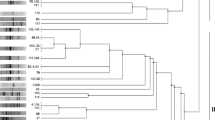Abstract
Using transponson Tn5 mutagenesis, two transconjugants of Bradyrhizobium japonicum with the properties of both phage resistance and ability to induce nodulation were isolated at the frequency of 0.02%. These transconjugants were tested for their symbiotic performance on soybean cv. JS335 under greenhouse and field conditions. Both phage-resistant mutants induced nodules (nod +), but the transconjugant B. japonicum E13 was ineffective in nitrogen fixation (fix -). Rhizobiophage presence in the inoculum of phage-resistant mutants did not influence the symbiotic effectiveness. The mixture of wild strain and phage in the inoculum caused reduced symbiotic performance under controlled conditions, while under a field environment phage (100 and 500 μl of ∼108 particles ml−1) presence did not have any recognizable effect on increased nodule dry weight, nitrogenase activity, or foliar N2 content. On the basis of restriction fragment length polymorphism analysis, phage-sensitive, less effective, homologous bradyrhizobia belonging to B. japonicum were detected in root nodules of both inoculated and uninoculated plants. Inoculation of a higher concentration of phage in the inoculum significantly reduced the symbiotic performance, while the lower concentration of phage did not show any effect on phage-susceptible, less effective, homologous bradyrhizobia or, thus, symbiotic efficiency under field conditions. The phage-resistant mutant B. japonicum A49 showed effective symbiosis as efficient as that of the wild strain. Inoculation of phage-resistant mutants with lytic phage may reduce the occupancy of phage-susceptible, ineffective/less effective/mediocre homologous bradyrhizobia strains under natural complex soil conditions.

Similar content being viewed by others
References
Abebe HM, Sadowsky MJ, Kinkle BK, Schmidt EL (1992) Lysogeny in Bradyrhizobium japonicum and its effect on soybean nodualtion. Appl Environ Microbiol 58:3360–3366
Appunu C, Dhar B (2006) Existence and characteristics of rhizobiophages in soybean grown fields in India. Asian J Plant Sci 5:818–821
Appunu C, Dhar B (2006) Phage typing of indigenous soybean-rhizobia and their relationship with symbiotic and asymbiotic nitrogen fixation. Indian J Exp Biol 44:1006–1011
Appunu C, Dhar B (2006) Differential symbiotic response of Bradyrhizobium japonicum phage-typed strains with soybean cultivars. J Microbiol 44:363–368
Appunu C, Dhar B (2006d) Symbiotic effectiveness of acid-tolerant Bradyrhizobium strains with soybean in low pH soils. Afr J Biotechnol 5:842–845
Appunu C, Dhar B (2008) Morphology and general characteristics of lytic phages infective on strains of Bradyrhizobium japonicum. Curr Microbiol 56:21–27
Appunu C, Sen D, Dhar B (2005) Acid and aluminium tolerance of Bradyrhizobium isolates from traditional soybean growing areas of India. Indian J Agr Sci 75:826–827
Barnet YM (1979) Properties of Rhizobium trifolii isolate surviving exposure to specific bacteriophages. Can J Microbiol 25:979–986
Giraud E, Moulin L, Vallenet D et al (2007) Legumes symbioses: absence of Nod genes in photosynthetic bradyrhizobia. Science 316:1307–1311
Green BM, Hashem F, Dadson R, Javaid I, Jag J (2005) Rhizobiophages impact on Bradyrhizobium japonicum proliferating in soybean rhizosphere. ASA-CSSA-SSSA International Annual Meetings, Salt Lake City, UT
Hashem FM, Angle JS (1988) Rhizobiophage effects of Bradyrhizobium japonicum, nodulation and soybean growth. Soil Biol Biochem 20:69–73
Hom SSM, Uratsu SL, Hoang F (1984) Transposon Tn5 induced mutagenesis of Rhizobium japonicum yielding a wide variety of mutants. J Bacteriol 159:335–340
Kim CH, Kuykendall LD, Shah KS, Keister DL (1988) Induction of symbiotically defective auxotrophic mutants of Rhizobium fredii HH303 by transposon mutagenesis. Appl Environ Microbiol 54:423–427
Kowalski M, Małek W, Dolecka CJ, Szlachetka M (2004) The effect of rhizobiophages on Sinorhizobium meliloti–Medicago sativa symbiosis. Biol Fertil Soils 39:292–294
Kuykendall LD (1987) Isolation and identification of genetically marked strains of nitrogen-fixing micro-symbionts of soybeans. In: Elkan GH (ed) Symbiotic nitrogen fixation technology. Dekker, New York, pp 205–220
Laguerre G, Allard MR, Revoy F, Amarger N (1994) Rapid identification of rhizobia by restriction fragment length polymorphism analysis of PCR-amplified 16S rRNA genes. Appl Environ Microbiol 60:56–63
Laguerre G, Mavingui P, Allard MR, Charnay MP, Louvrier P, Mazurier SI, Rigottier-Gois L, Amarger N (1996) Typing of rhizobia by PCR DNA fingerprinting and PCR-restriction fragment length polymorphism analysis of chromosomal and symbiotic gene regions: application to Rhizobium leguminosarum and its different biovars. Appl Environ Microbiol 62:2029–2036
Navarro E, Simonet P, Normand P, Bardin R (1992) Characterization of natural populations of Nitrobacter spp. Using PCR/RFLP analysis of the ribosomal intergenic spacer. Arch Microbiol 157:107–115
Patel JJ (1978) Symbiotic effectiveness of phage resistant mutants of two strains of Lotus rhizobia. Plant Soil 49:251–257
Peoples MB, Herridge DF, Ladha JK (1995) Biological nitrogen fixation: an efficient source of nitrogen for sustainable agricultural production? Plant Soil 174:3–28
Ponsonnet C, Nesme X (1994) Identification of Agrobacterium strains by PCR-RFLP analysis of pTi and chromosomal regions. Arch Microbiol 161:300–309
Rostas K, Sista PR, Stanley J, Verma DPS (1984) Transposon mutagenesis of Rhizobium japonicum. Mol Gen Genet 197:230–235
Sadowsky MJ, Rostas K, Sista PR, Bussey H, Verma DPS (1986) Symbiotically defective histidine auxotrophs of Bradyrhizobium japonicum. Arch Microbiol 144:334–339
Selvaraj G, Iyer VN (1983) Suicide plasmid vehicles for insertion mutagenesis in Rhizobium meliloti and related bacteria. J Bacteriol 156:1292–1300
So JS, Hodgson LM, Haugland R, Leavitt M, Banfalvi Z, Nieuwkoop AJ, Stacey G (1987) Transposon-induced symbiotic mutants of Bradyrhizobium japonicum: isolation of two gene regions essential for nodulation. Mol Gen Genet 207:15–23
Vincent JM (1970) A manual for the practical study of root nodule bacteria—IBH Hand Book. Blackwell Scientific, Oxford and Edinburgh
Acknowledgments
The first author thanks the Council of Scientific and Industrial Research-University Grant commission for the Senior Research Fellowship award to carry out this experiment. We express our sincere thanks to Dr. Ajay Kumar Parida, Program Director, MSSRF, Chennai, for providing the facility to do the sequencing for our native soybean root nodule isolates.
Author information
Authors and Affiliations
Corresponding author
Rights and permissions
About this article
Cite this article
Appunu, C., Dhar, B. Isolation and Symbiotic Characteristics of Two Tn5-Derived Phage-Resistant Bradyrhizobium japonicum Strains that Nodulate Soybean. Curr Microbiol 57, 212–217 (2008). https://doi.org/10.1007/s00284-008-9176-y
Received:
Accepted:
Published:
Issue Date:
DOI: https://doi.org/10.1007/s00284-008-9176-y




